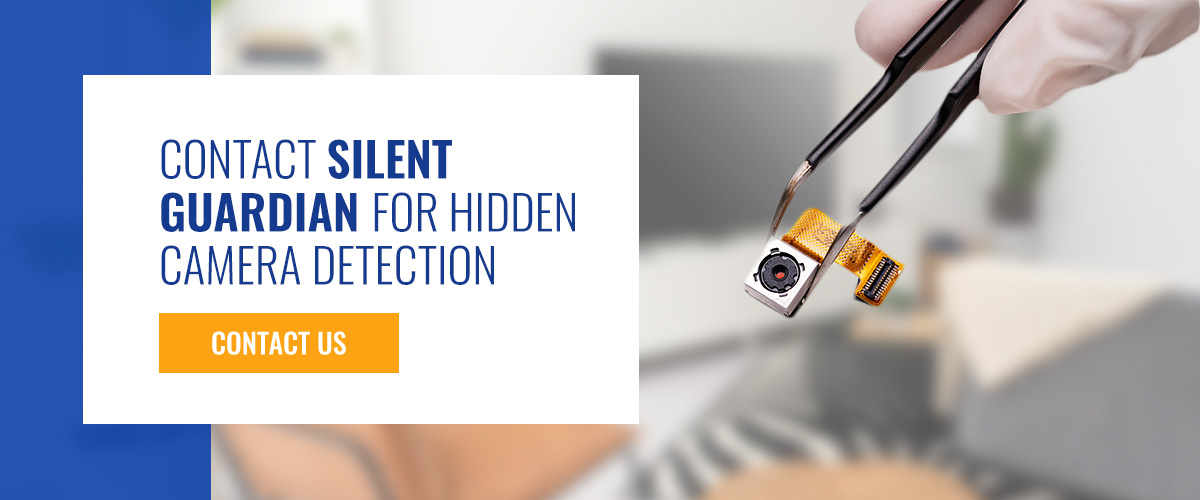Sep 2024
How to Detect Hidden Cameras
Criminals are becoming more strategic in invading our privacy. Many of them listen to our conversations in our homes, cars and businesses. This may sound like a conspiracy theory or a movie night special. However, the news and investigative reports have discussed these disturbing incidents that have occurred at rental and vacation Airbnb houses, for instance.
Some indoor locations where cameras are most likely hidden are smoke detectors, air filter equipment, books, wall decor, electrical outlets, desk plants, tissue boxes, teddy bears, DVD cases, lava lamps, shelves, table tops and couch cushions. In the outdoors, the most common positions where microphones and cameras are hidden are house plants, holes in doors, the roof and the doorbell.
Hidden Camera Detection Tricks
Hidden Camera Detection Tricks
Because of these incidents, experts have developed camera detection tricks that are important to learn about. Here are a few to get you started:
Do a Physical or Manual Inspection
Physical or manual inspection is one of the easiest and quickest ways to detect a hidden camera or microphone. Below are a few tricks you can use to pull through successfully:
- Use a flashlight: Flashlights are the most basic way to find a hidden camera. Just power on the flashlight, power off the room’s lights and inspect the entire room with the flashlight. Move slowly to ensure you conduct a thorough examination to catch any suspicious signs, such as objects in unusual positions.
- Search for holes: Gaps and holes in the walls can be easy spots for tucking in a small camera or microphone. Check these first before you go to the hard-to-think-of places in a room.
- Carefully scan the rest of the area to detect hidden cameras: This approach is most effective if you have enough time. You can check the environment inch-by-inch, starting in the obvious locations. Hallmarks of hidden cameras include suspicious wires, lenses or lights. Motion sensor cameras have almost an inaudible buzz, so listen carefully as you walk through the room. Also, unplug unusual power adaptors or outlets.
- Recognize objects that don’t fit in: By keen observation, you can easily spot decorative objects on the walls or cabinets that seem odd or out of place. These can be things like dolls, smoke detectors and alarm clocks.
Scan Through Nearby Wi-Fi Networks
Some cameras connect to Wi-Fi so that owners can monitor them remotely, making it easier to find them if you’re connected to the same network. You can do this by scanning your Wi-Fi network to detect foreign or unrecognized devices with names like “MyCam” or “InteriorCam.”
You’ll need a network scanner app, which you can download from your phone’s app store. You can then connect the app to the same network and run the scan to detect foreign devices on your Wi-Fi.
Use Your Cell Phone
Androids and iPhones are another easy way to detect hidden cameras. You can use them in three different ways to detect hidden cameras and motion sensors in your room:
- Use a mobile app: Mobile apps for Androids and iPhones can help detect hidden cameras by examining magnetic fields and analyzing lens reflections. Once you find a trusted app, you can install, launch and use it to detect any hidden cameras around you.
- Inspect the surroundings through the front camera: Your front camera can effectively detect infrared lights, which are often used in sensor cameras for night vision. The best way to get quick results is to turn off the lights and move slowly with your camera to pick up on infrared lights that might appear as small, bright dots on your camera screen.
- Test the signals: When you make a phone call where you suspect a hidden camera could be, you might realize a break in signal transmission. Such signal interference could rightly indicate there’s a hidden camera around the area using wireless transmission.
Obtain a Radio Frequency Sensor or Detector
Several detectors can effectively find signals or other evidence of hidden bugs and microphones. You can buy civilian versions online, but these can be expensive — up to hundreds of dollars. It’s best to go with what fits your budget and needs. Once you have one, you might want to follow these steps for effective results:
- Clear the area of any interference: Start by switching off and unplugging all possible interference from other electronic devices, such as radios, TVs, routers, microwaves and modems. Doing this narrows down true positives to the only electronic devices that remain on during the search.
- Perform the scan methodically: Slowly hover the detector around the areas you suspect could have a hidden camera and even less obvious spots so you can maximize your chances of finding the cameras.
- Be attentive to alerts: An auditory signal should alert you to radio frequencies that could be from a camera you’re looking to find. Hover around those areas until the signal intensifies so you know where to start tracing out the camera.
- Repeat for suspicious areas: If you suspect specific areas that weren’t clearly picked by the sensor, it’s important you repeat the process over these areas for confirmation.
Contact Silent Guardian for Hidden Camera Detection
Detecting a hidden camera in a room might not always be as simple as it sounds. Even with the tips above, you’ll need professional help to detect most hidden surveillance cameras or microphones. If you suspect there’s a hidden camera or microphone in the room, it’s best to contact a professional like Silent Guardian.
Our experts have mastered how to detect hidden cameras in a home and other buildings and can help remove unwanted spy cameras from your space. At Silent Guardian, we use state-of-the-art equipment to find hidden cameras and microphones in a variety of situations. Fill out our contact form today for effective hidden camera detection in New York.

